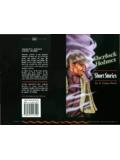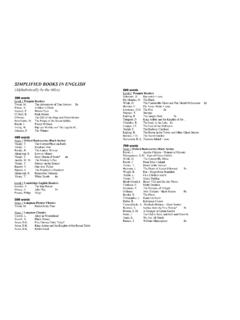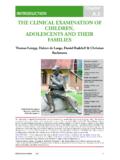Transcription of Predicting the Future With Social Media - arXiv
1 [ ] 29 Mar 2010 Predicting the Future with Social MediaSitaram AsurSocial Computing LabHP LabsPalo Alto, CaliforniaEmail: A. HubermanSocial Computing LabHP LabsPalo Alto, CaliforniaEmail: In recent years, Social Media has become ubiquitousand important for Social networking and content sharing. Andyet, the content that is generated from these websites remainslargely untapped. In this paper, we demonstrate how Social mediacontent can be used to predict real-world outcomes. In particular,we use the chatter from to forecast box-officerevenues for movies.
2 We show that a simple model built fromthe rate at which tweets are created about particular topicscanoutperform market-based predictors. We further demonstratehow sentiments extracted from Twitter can be further utilized toimprove the forecasting power of Social INTRODUCTIONS ocial Media has exploded as a category of online discoursewhere people create content, share it, bookmark it and networkat a prodigious rate. Examples include Facebook, MySpace,Digg, Twitter and JISC listservs on the academic side. Becauseof its ease of use, speed and reach, Social Media is fastchanging the public discourse in society and setting trendsand agendas in topics that range from the environment andpolitics to technology and the entertainment Social Media can also be construed as a form ofcollective wisdom, we decided to investigate its power atpredicting real-world outcomes.
3 Surprisingly, we discoveredthat the chatter of a community can indeed be used to makequantitative predictions that outperform those of artificialmarkets. These information markets generally involve thetrading of state-contingent securities, and if large enough andproperly designed, they are usually more accurate than othertechniques for extracting diffuse information, such as surveysand opinions polls. Specifically, the prices in these marketshave been shown to have strong correlations with observedoutcome frequencies, and thus are good indicators of futureoutcomes [4], [5].
4 In the case of Social Media , the enormity and high vari-ance of the information that propagates through large usercommunities presents an interesting opportunity for harnessingthat data into a form that allows for specific predictionsabout particular outcomes, without having to institute marketmechanisms. One can also build models to aggregate theopinions of the collective population and gain useful insightsinto their behavior, while Predicting Future trends. Moreover,gathering information on how people converse regarding par-ticular products can be helpful when designing marketing andadvertising campaigns [1], [3].
5 This paper reports on such a study. Specifically we considerthe task of Predicting box-office revenues for movies usingthe chatter from Twitter, one of the fastest growing socialnetworks in the Internet. Twitter1, a micro-blogging network,has experienced a burst of popularity in recent months leadingto a huge user-base, consisting of several tens of millions ofusers who actively participate in the creation and propagationof have focused on movies in this study for two mainreasons. The topic of movies is of considerable interest amongthe Social Media user community, characterized both bylarge number of users discussing movies, as well as asubstantial variance in their opinions.
6 The real-world outcomes can be easily observed frombox-office revenue for goals in this paper are as follows. First, we assess howbuzz and attention is created for different movies and how thatchanges over time. Movie producers spend a lot of effort andmoney in publicizing their movies, and have also embracedthe Twitter medium for this purpose. We then focus on themechanism of viral marketing and pre-release hype on Twitter,and the role that attention plays in forecasting real-worldbox-office performance. Our hypothesis is that movies that are welltalked about will be , we study how sentiments are created, how positive andnegative opinions propagate and how they influence a bad movie, the initial reviews might be enough todiscourage others from watching it, while on the other hand,itis possible for interest to be generated by positive reviewsandopinions over time.
7 For this purpose, we perform sentimentanalysis on the data, using text classifiers to distinguishpositively oriented tweets from chief conclusions are as follows: We show that Social Media feeds can be effective indica-tors of real-world performance. We discovered that the rate at which movie tweetsare generated can be used to build a powerful modelfor Predicting movie box-office revenue. Moreover ourpredictions are consistently better than those producedby an information market such as the Hollywood StockExchange, the gold standard in the industry [4].
8 1 Our analysis of the sentiment content in the tweets showsthat they can improve box-office revenue predictionsbased on tweet rates only after the movies are paper is organized as follows. Next, we survey recentrelated work. We then provide a short introduction to Twitterand the dataset that we collected. In Section 5, we study howattention and popularity are created and how they then discuss our study on using tweets from Twitterfor Predicting movie performance. In Section 6, we presentour analysis on sentiments and their effects.
9 We concludein Section 7. We describe our prediction model in a generalcontext in the RELATEDWORKA lthough Twitter has been very popular as a web service,there has not been considerable published research on and others [2] studied the Social interactions onTwitter to reveal that the driving process for usage is a sparsehidden network underlying the friends and followers, whilemost of the links represent meaningless interactions. Javaetal [7] investigated community structure and isolated differenttypes of user intentions on Twitter.
10 Jansen and others [3]have examined Twitter as a mechanism for word-of-mouthadvertising, and considered particular brands and productswhile examining the structure of the postings and the changeinsentiments. However the authors do not perform any analysison the predictive aspect of has been some prior work on analyzing the correlationbetween blog and review mentions and performance. Gruhland others [9] showed how to generate automated queriesfor mining blogs in order to predict spikes in book while there has been research on Predicting movie sales,almost all of them have used meta-data information on themovies themselves to perform the forecasting, such as themovies genre, MPAA rating, running time, release date, thenumber of screens on which the movie debuted, and thepresence of particular actors or actresses in the cast.
![arXiv:0706.3639v1 [cs.AI] 25 Jun 2007](/cache/preview/4/1/3/9/3/1/4/b/thumb-4139314b93ef86b7b4c2d05ebcc88e46.jpg)

![arXiv:1301.3781v3 [cs.CL] 7 Sep 2013](/cache/preview/4/d/5/0/4/3/4/0/thumb-4d504340120163c0bdf3f4678d8d217f.jpg)
![@google.com arXiv:1609.03499v2 [cs.SD] 19 Sep 2016](/cache/preview/c/3/4/9/4/6/9/b/thumb-c349469b499107d21e221f2ac908f8b2.jpg)












